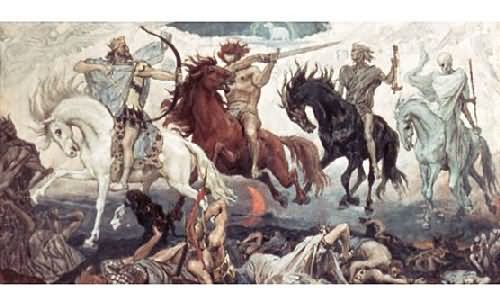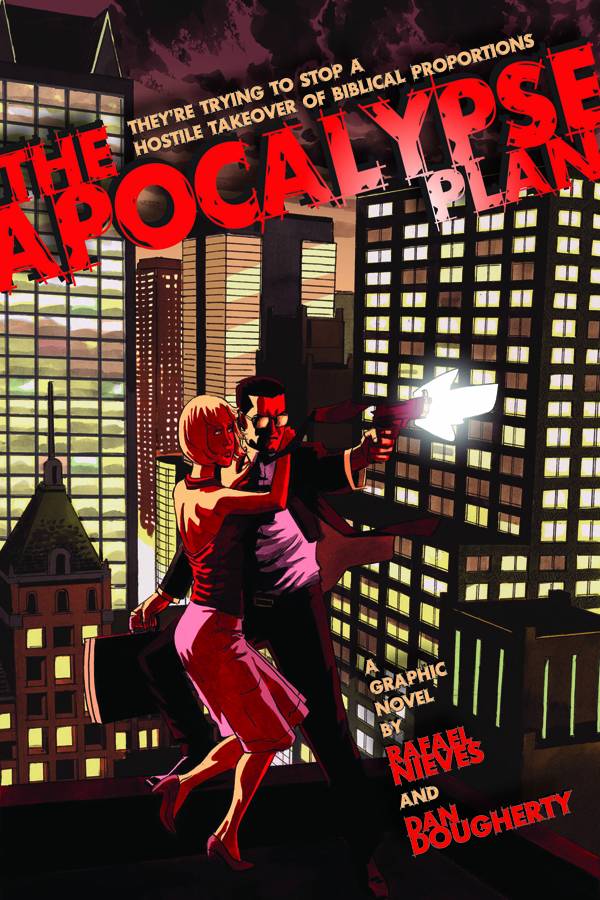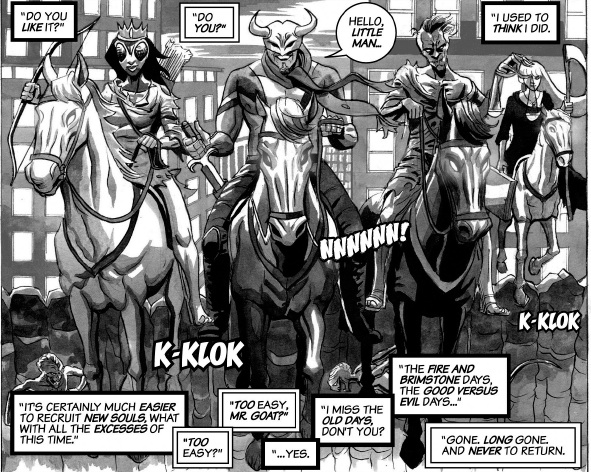Welcome to Comics Are My Religion, a look at theology through the lens of comic books. There are some basic ground rules about engaging in respectful dialog about religion in this column. There be spoilers ahead, so beware!
 “Then I saw the Lamb open one of the seven seals, and I heard one of the four living creatures call out, as with a voice of thunder, ‘Come!’ I looked, and there was a white horse! Its rider had a bow; a crown was given to him, and he came out conquering and to conquer. When he opened the second seal, I heard the second living creature call out, ‘Come!’ And out came another horse, bright red; its rider was permitted to take peace from the earth, so that people would slaughter one another; and he was given a great sword. When he opened the third seal, I heard the third living creature call out, ‘Come!’ I looked, and there was a black horse! Its rider held a pair of scales in his hand, and I heard what seemed to be a voice in the midst of the four living creatures saying, ‘A quart of wheat for a day’s pay, and three quarts of barley for a day’s pay, but do not damage the olive oil and the wine!’ When he opened the fourth seal, I heard the voice of the fourth living creature call out, ‘Come!’ I looked and there was a pale green horse! Its rider’s name was Death, and Hades followed with him; they were given authority over a fourth of the earth, to kill with sword, famine, and pestilence, and by the wild animals of the earth.” Revelation 6:1-8
“Then I saw the Lamb open one of the seven seals, and I heard one of the four living creatures call out, as with a voice of thunder, ‘Come!’ I looked, and there was a white horse! Its rider had a bow; a crown was given to him, and he came out conquering and to conquer. When he opened the second seal, I heard the second living creature call out, ‘Come!’ And out came another horse, bright red; its rider was permitted to take peace from the earth, so that people would slaughter one another; and he was given a great sword. When he opened the third seal, I heard the third living creature call out, ‘Come!’ I looked, and there was a black horse! Its rider held a pair of scales in his hand, and I heard what seemed to be a voice in the midst of the four living creatures saying, ‘A quart of wheat for a day’s pay, and three quarts of barley for a day’s pay, but do not damage the olive oil and the wine!’ When he opened the fourth seal, I heard the voice of the fourth living creature call out, ‘Come!’ I looked and there was a pale green horse! Its rider’s name was Death, and Hades followed with him; they were given authority over a fourth of the earth, to kill with sword, famine, and pestilence, and by the wild animals of the earth.” Revelation 6:1-8
Raise your hand if you think the Book of Revelation is one of the creepiest books you’ve ever read. And to think–it’s in the Bible! For centuries people have been trying to unravel the mystery that comes from the last book of the New Testament. Many folks have dreamed this tale as some kind of fantasy-horror tome and many people, both faithful Christians and non-Christians alike, like to take this book about a vision and turn it into something way too literal.
 Last month I covered the Graven Images book, in which the first essay by Aaron Ricker Parks talks in depth about the misinterpretation of the Revelation to John, incorrectly called “Revelations” by the biblically challenged. It’s also wrongly attributed to the apostle John, when most scholars believe that John of Patmos was the one who received the “apocalypse.” Even that word, “apocalypse,” has been appropriated to now signify the end of the world rather than its original meaning of the “lifting of the veil” that John of Patmos received. In his essay “The Devil’s Reading,” Parks keenly points out that the more sadomasochistic version of Christ that many have discovered in Revelation has made for some really popular reading in the world of comics, from Chick Tracts to DC’s Kingdom Come to war comics of the 1940s, but ultimately is a skewed reading of the book.
Last month I covered the Graven Images book, in which the first essay by Aaron Ricker Parks talks in depth about the misinterpretation of the Revelation to John, incorrectly called “Revelations” by the biblically challenged. It’s also wrongly attributed to the apostle John, when most scholars believe that John of Patmos was the one who received the “apocalypse.” Even that word, “apocalypse,” has been appropriated to now signify the end of the world rather than its original meaning of the “lifting of the veil” that John of Patmos received. In his essay “The Devil’s Reading,” Parks keenly points out that the more sadomasochistic version of Christ that many have discovered in Revelation has made for some really popular reading in the world of comics, from Chick Tracts to DC’s Kingdom Come to war comics of the 1940s, but ultimately is a skewed reading of the book.
Revelation is more accurately read in light of the early Christian persecution that took place at the end of the 1st century. Revelation was written to give hope to a community who were being jailed, beaten, tortured, and killed for proclaiming a king other than Caesar. The new religion of Christianity was under extreme scrutiny by both leaders of older religions and by the governmental and society authorities. Whether John received this as a fever-dream vision or if he wrote this book in code to evade further persecution is a mystery. But the ultimate purpose of Revelation, I contend, is to give hope to those who have none, knowing that ultimately, victory belongs to Christ. Revelation is better read, in my opinion, metaphorically and not literally, although the images found within are quite vivid, and some even grotesque.
 Perhaps one of the more vivid scenes in Revelation that people like to visualize in comic form comes from chapter 6. The Lamb of God, who is commonly identified as Jesus Christ, opens a series of seals which unleash the ultimate judgment of God upon the world. Keep in mind, this is to be read metaphorically, so John’s view of the world is one where God needs to come and clean up, since the obvious “good guys” are under such persecution and trial. The Lamb opens the seals and sends four riders on horseback to execute this judgment.
Perhaps one of the more vivid scenes in Revelation that people like to visualize in comic form comes from chapter 6. The Lamb of God, who is commonly identified as Jesus Christ, opens a series of seals which unleash the ultimate judgment of God upon the world. Keep in mind, this is to be read metaphorically, so John’s view of the world is one where God needs to come and clean up, since the obvious “good guys” are under such persecution and trial. The Lamb opens the seals and sends four riders on horseback to execute this judgment.
In many comics today, the Four Horsemen are generally viewed as bad guys. The most mainstream example of this is found in Marvel’s X-Men canon, where the ancient mutant Apocalypse, who is uber-Darwinian and seeks the eradication of the lesser species of homo-sapiens, calls out his Four Horsemen to do his dirty work until the X-Men save the day. Most recently, a new set of Horsemen appeared in the pages of Uncanny X-Force. So to discover that Jesus Christ is the one who unleashes the Four Horsemen in Revelation can be quite a surprise to the uninitiated. Modern interpretation is that Christ does this as an allowance of humanity’s free will. Opening of the seals and sending the horsemen of famine, pestilence, war, and death is a result of what we as humans already choose to do with our greed, violence, and sinful natures. The Lamb lets this occur so that ultimately humanity can be redeemed and the Kingdom of God can be ushered in. However, the struggle that comes from this mysterious biblical book lingers, and at face value the Lamb becomes a very gray character.

Recently, I read the graphic novel The Apocalypse Plan by Rafael Nieves and Dan Dougherty, which highlights the ambiguity of the actions of Christ in sending the four horsemen. In the book, the ancient tale as depicted in Revelation is modernized. The forces of Christ and Satan are rival companies, the Grace Corporation and Morningstar, Inc., who begin an eternal struggle of hostile takeover. The plan is initiated by Mr. Lamb who receives envelopes and breaks their seals to begin the game. The “horsemen” are sent to Morningstar to begin the takeover. An agent by the name of Abaddon is sent to find out who’s behind the violent deaths that are occurring at Morningstar. Abaddon is the central character who has to solve the crime and take down the culprits, who are the four horsemen sent by Mr. Lamb. Ultimately, Abaddon is discovered to be a demon whom the reader finds himself rooting for against the even more morally absent horsemen.
What I find in The Apocalypse Plan is a creative spin on the book of Revelation. No one is clearly good and no one is clearly bad. Like the tones of the ink-wash of the book, everyone is gray, most especially Mr. Lamb, who tells Michael (the “archangel”) when asked, “What have you done?”, that he is only doing his father’s will, “regardless what I think. What I feel. Same as you, Michael. We all play our parts. Forgive us…we know exactly what we do…” with a tear in his eye and a deranged smile on his face.

Nieves’s book is not a literal retelling of Revelation, although it does wrestle with the literal sensibilities that most interpreters give it. Much like Aaron Ricker Parks’s essay, Nieves finds the entertainment in the sadomasochistic element that is commonly read in Revelation. In its originality, it is done extremely well. While Abaddon is just as evil and violent as anyone else in the book, I found myself thinking he was a sympathetic and vulnerable character. He himself gets snookered by one of the horsemen posing as an intern at Morningstar. He gets wounded numerous times, even though he’s ultimately an invulnerable force. Abaddon is caught in this struggle between Lamb and his adversary (cutely dubbed Mr. Goat), but has an ultimate weapon of his own in a mysterious briefcase.
The end of the book is as ambiguous as the morality of the characters. Who actually wins in the battle between good and evil? If it’s a battle in the literal sense, then no one. And that’s where I agree with Parks’s assessment of the depiction of Revelation in comics. When the violence of Revelation is taken to a literal extreme, it’s not really a helpful interpretation. It becomes that creepy biblical text that we love to scrutinize. The Apocalypse Plan is just about as good as any graphic form of parts of Revelation I’ve ever seen, mainly because it draws upon that morally ambiguous question of the purpose of Revelation. Nieves has hinted that there may be more in store for readers of this book and I am interested in seeing where he goes with it, since there is much more creativity to mine from Revelation. For now, I encourage readers of Revelation to go back and do their homework, looking at the historical and textual analysis of the scriptures to see what further can be drawn from the story beneath the story. You may find even more fascinating and relevant stories to be told.
Jeff Jackson
jeff@comicattack.net



Very interesting concept! Good discussion on the Cooler about this book by the way people!
That’s a weird thing for me…. We’re taught the Bible is THE word of God, so many people take it so literally. I don’t know many Christians who look at in through its historical context (I think you’re the first, actually). I’d actually never considered that before. Partly because to me, if you start taking it into a historical perspective, then you’re treating it as any other book. It’s hard to separate it or view it like that.
I don’t take the Bible literally word for word, for the record. But that’s more because it’s been tampered with by man. And also because I believe we were given the intelligence to interpret the Word.
That’s nice of you to say, Kristin, but I’m definitely not the first. People think that in order for the Bible to have truth, it has to be historically factual. I believe Revelation contains truth, but it’s a truth that is deeper than literal. The point of Revelation is that in the end, God will restore and redeem all things. There will be justice for those who have none, unity where there is division, etc. While the details are fun to imagine, the truth contained in Revelation is much deeper and metaphorical.
Also, I believe the Bible to be the Word of God, too, so it’s not mutually exclusive to believe that the Word of God can be metaphorical. Those words have a deeper meaning and truth than what is just on the page.
Pingback: Comics A.M. | Bankrupt Borders chain could be history by next week | Robot 6 @ Comic Book Resources – Covering Comic Book News and Entertainment
I know, it’s just…a little contradictory for me. I love to study literature, and literature is heavily invested in its historical context. But thinking of the Bible that way is weird to me, because I was taught it more literally and factual. I decided on my own not to interpret it literally because I saw what doing so does to religion and the people who follow it. Oddly, it creates hatred and ignorance. I guess I’m still trying to figure out what it means to me.
Jeff, I really learn a lot from your columns and enjoy the chance to think a bit more about my beliefs. 🙂
Thanks! I learn a lot too!
Pingback: Rao Reads the Blogs « By Rao! Comics and Religion